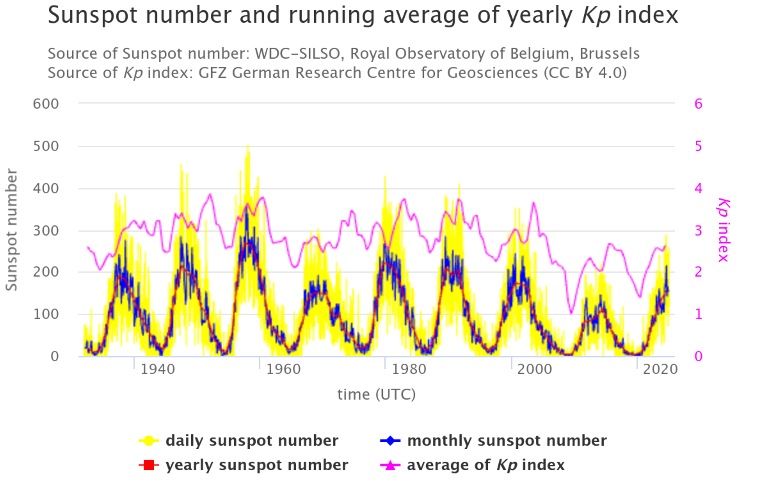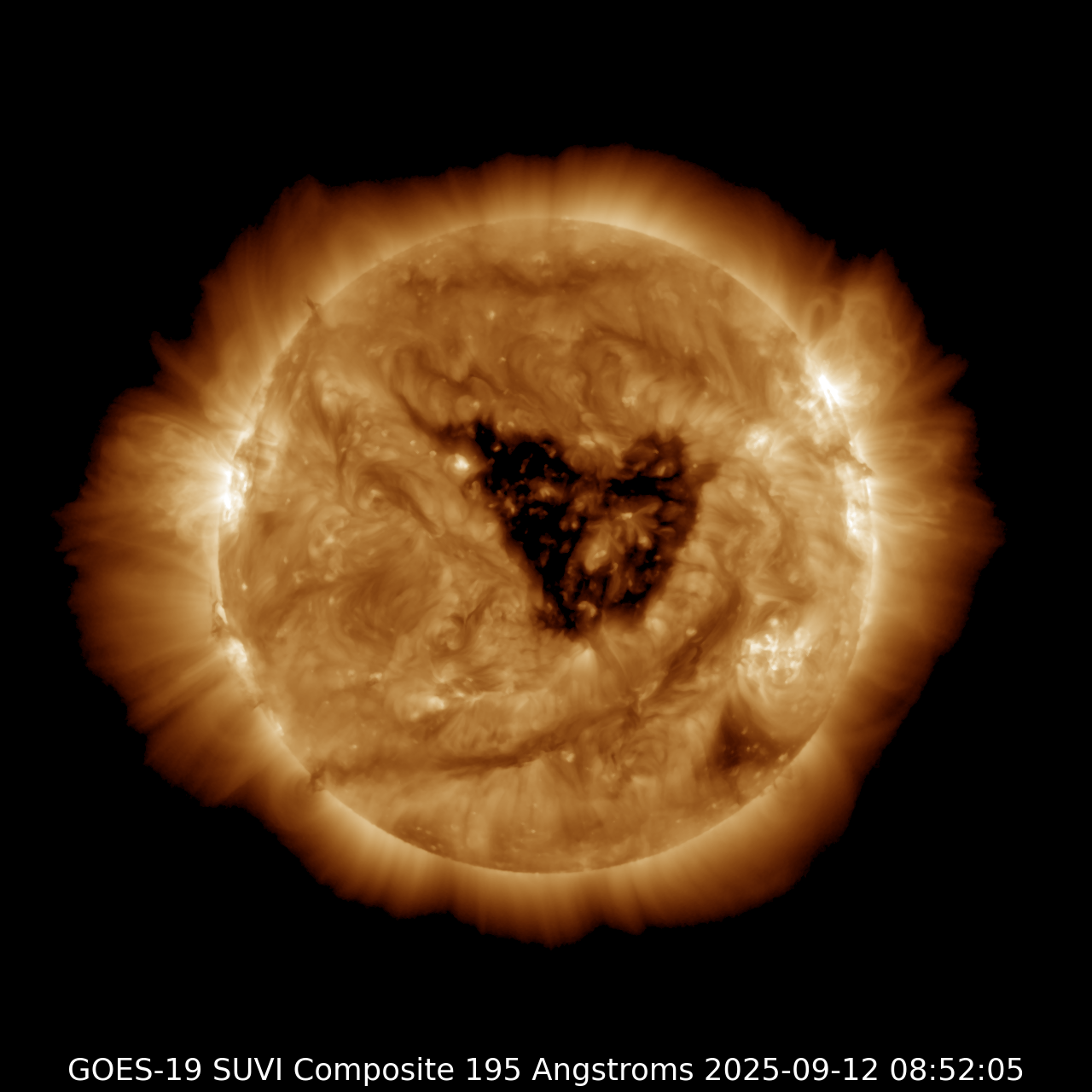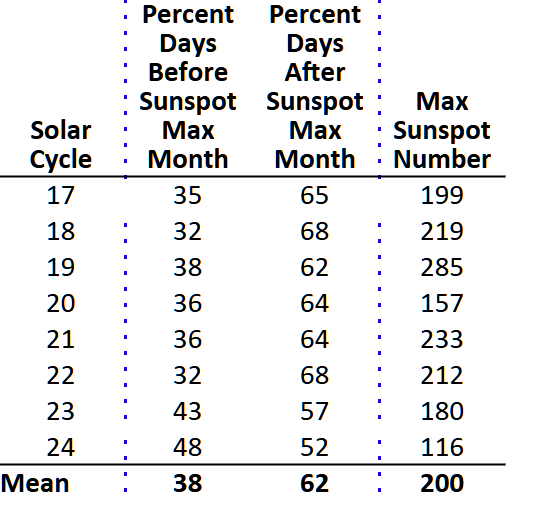— by
K. Fisher fisherka@ipns.comThe year 2024 was exceptional for aurora enthusiasts. A rare event in May pushed the Kp index above 9, creating stunning displays visible as far south as New Mexico. While some observers feel the frequency of major events is declining, the question remains: How many more spectacular auroras can we expect for the remaining of Solar Cycle 25? This note estimates remaining KP events > 6 and KP > 7 in Cycle 25. As of January 2025, that crude estimate is, globally, ≈ 150 events KP > (6,7\] and ≈ 50 events KP > (7,8\] (Table 2). These global estimates are not adjusted for local circumstances. Expected local events are much lower, allowing for weather, daylight and the likelihood of a solar event occurring over a specific geographical location.
NASA and NOAA reported solar maximum for Cycle 25 began in October 2024. However, the exact peak month won't be known for some time. (Interrante.) The Solar Cycle Prediction Panel, a panel of international experts that is co-chaired by NASA and NOAA, forecasts the Cycle 25 sunspot maximum around May 2025. (SWPC 2025.)
Significant high Kp levels and their associated storms often occur during a solar cycle's declining phase. For example, the Halloween Solar Storm of 2003 happened about two years after Solar Cycle 23's maximum (Astronomy Mag., Berman, 2016, Figure 1, Table 1, below.)
Figure 1 - Maximum Kp Levels Occur after the Sunspot Minimum. Solar Cycles 17-24.

Source: GFZ.
Table 1 Percent of Kp =\> 6.0 Events before and after the Sunspot Max Month
| Solar Cycle | 7 to 0 Years before Sunspot Max Date (%) | 7 to 0 Years after Sunspot Max Date (%) |
|---|---|---|
| 17 | 7.8 | 92.2 |
| 18 | 28.0 | 72.0 |
| 19 | 35.3 | 64.7 |
| 20 | 24.0 | 76.0 |
| 21 | 30.8 | 69.2 |
| 22 | 25.1 | 74.9 |
| 23 | 44.9 | 55.1 |
| 24 | 41.4 | 58.6 |
| Mean | 29.6 | 70.4 |
Source: GFZ. Historical Kp data for Solar Cycles 17--24; Author analysis. Notes: Limited to events greater than Kp 6.0. Rows total to 100%.
Professional solar scientists have not made rigorous estimates of the expected high Kp events for the remainder of Solar Cycle 25. A rough estimate can be based on the assumption that Cycle 25 will be similar to Cycle 20 at around a Maximum Sunspot Number of 154 (see SIDC 2025). That estimate (Table 2) suggests about 200 more high-intensity aurora events (Kp \> 6) have yet to occur.
Table 2 – Cycle 20 Kp Counts Less Partial Cycle 25 Kp Counts by Kp Group
| Solar Cycle | Kp Group [0,5] | (5,6] | (6,7] | (7,8] | (8,9] | Total | Duration (Yrs) | Max Sunspot Number |
|---|---|---|---|---|---|---|---|---|
| 20 | 32,366 | 678 | 202 | 67 | 24 | 33,337 | 11.5 | 156.6 |
| 25 | 14,436 | 111 | 54 | 18 | 13 | 14,632 | 5.0 | 154.0 |
| Difference | 17,930 | 567 | 148 | 49 | 11 | 18,705 | 6.5 | 2.6 |
Source: GFZ. Historical Kp data for Solar Cycles 17--24; Author analysis; SDIC "Cycles Duration"; Author Analysis. Notes: Max Sunspot Number for current Cycle 25 is estimated from the Solar Cycle Prediction Panel smoothed monthly value for May 2025 (SWPC 2015). The sum of the counts in Kp groups (6,7\], (7,8\], and (8,9\] is 208.
About one-half of those 200 high Kp events occur on average within three years of Sunspot Maximum. (Supplemental Table 1.) This is a global estimate that does not account for likelihood of visibility at a particular geographic location, e.g., many events will occur during local nighttime or during cloudy weather. This estimate indicates that locally mid-latitude observers still will have plenty to look forward to during the remainder of Cycle 25. Why is there a time lag between the Sunspot Maximum Month and the maximum of Kp events? Dr. Tabitha Skov, an adjunct professor of heliophysics and space weather at Millerville University and the presenter of the popular "Spaceweather Woman" YouTube series, notes that "\[d\]uring the declining phase of the solar cycle, coronal holes become large, trans-equatorial, and persistent, lasting many solar rotations." This causes extended geomagnetic storms as often as every two weeks. Some storms last 6 months and can generate 6-12 high Kp storms, she noted.
Figure 2 - Large Coronal Hole on Sun's Disk on Sept. 12, 2025.

Source: SWPC. Notes: This Coronal Hole System (CHS) spans the differing polarity of the Northern and Southern Solar hemispheres. This CHS produced a Kp 7 event over Europe and parts of the Eastern and Midwest United States on September 14, 2025.
For aurora chasers, two qualities are essential: optimism and patience. Cycle 25 could end anywhere from 2032 (2025 plus 6.5 years) to 2034 (SWPC 2025). We are not yet half-way through Cycle 25. While the frequency of events may appear to decrease from the fall 2024 and during spring 2025, the potential for more breathtaking displays remains high throughout the remainder of Solar Cycle 25.
Conclusion
As of January 2025, remaining crude KP estimates are, globally, ≈ 150 events KP > (6,7\] and ≈ 50 events KP > (7,8\] (Table 2). These global estimates are not adjusted for local circumstances. These global estimates are not adjusted for local circumstances. Expected local events are much lower, allowing for weather, daylight and the likelihood of a solar event occurring over a specific geographical location.References
Berman, Bob. Jun. 27, 2016. Could a solar storm shut down the Earth? Astronomy Magazine. https://www.astronomy.com/observing/could-a-solar-storm-shut-down-earth/
GFZ German Research Centre for Geosciences. Accessed January 12, 2025. Chart. Sunspot number and running average of yearly Kp Index Web. https://kp.gfz-potsdam.de/en/figures/sunspot-numbers-and-kp
Interrante, Abbey. October 15, 2024. NASA, NOAA: Sun Reaches Maximum Phase in 11 Year Cycle. NASA Science News. Web. https://science.nasa.gov/science-research/heliophysics/nasa-noaa-sun-reaches-maximum-phase-in-11-year-solar-cycle/
Royal Observatory of Belgium, Solar Influences Data Center (SIDC). Accessed January 12, 2025. Web. https://www.sidc.be/SILSO/cyclesmm
Space Weather Prediction Center, NASA-NOAA. Accessed January 12, 2025. Solar Cycle Progression. Web. https://www.swpc.noaa.gov/products/solar-cycle-progression
Supplemental Materials
R Code, data and sample output used to generate this author's tables can be downloaded from directory: https://drive.google.com/drive/folders/1VVzJc3o6KENnpJMxrhLT85DFAWe4ycuK?usp=sharing
Supplemental Materials
Table S1 - Percent of KP \> 6 events before and after solar max date. Solar Cycles 17-24.

Source: GFZ German Research Centre for Geosciences; Author's Analysis.